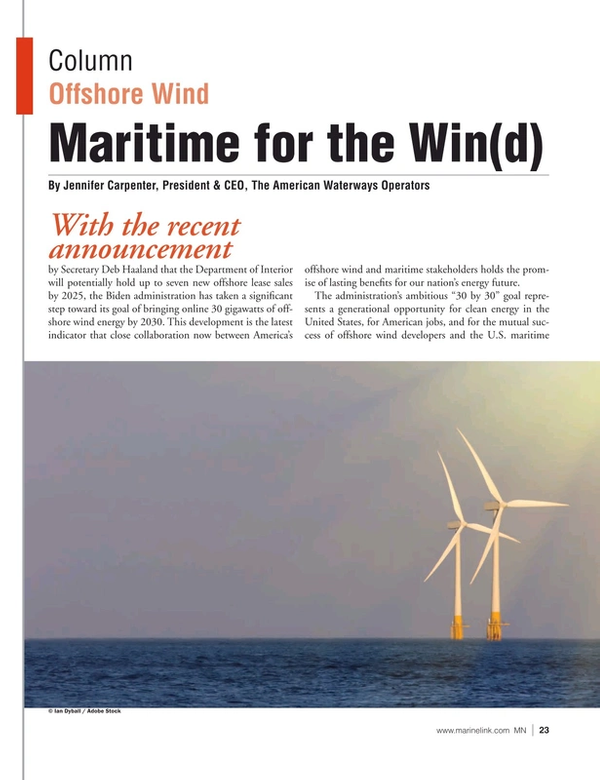
Maritime for the Win(d)
With the recent announcement by Secretary Deb Haaland that the Department of Interior will potentially hold up to seven new offshore lease sales by 2025, the Biden administration has taken a significant step toward its goal of bringing online 30 gigawatts of offshore wind energy by 2030. This development is the latest indicator that close collaboration now between America’s offshore wind and maritime stakeholders holds the promise of lasting benefits for our nation’s energy future.
The administration’s ambitious “30 by 30” goal represents a generational opportunity for clean energy in the United States, for American jobs, and for the mutual success of offshore wind developers and the U.S. maritime industry. Working together, offshore wind developers and U.S. maritime companies can seize this moment to create the next great American industry, sustained by a made-in-America supply chain that will help ensure the reliability of this emergent energy source for the long-term.
American maritime is ready, willing and able to produce the vessels that will be needed to service this market, and help create an environment that makes such investments viable. From historic investments in the first Jones Act-compliant wind turbine installation vessel, to special operations vessels, crew transfer vessels, feeder barges, and port and workforce development partnerships, American companies are already taking steps to build a solid foundation for moving offshore wind forward in the United States.
So how do we spur investment in the fleet of vessels that will be necessary to support all phases of the offshore wind project lifecycle—surveying and site preparation, development and construction, operations and maintenance, and eventual decommissioning?
There are four key steps that need to be taken to accelerate this process.
First, American offshore wind and maritime need to mutually understand and acknowledge the ground rules. In the case of offshore wind vessels, Congress has spoken—as recently as January 1—with legislation clarifying that the Constitution and all U.S. laws apply to renewable energy development on the Outer Continental Shelf. Crucially, “all U.S. laws” includes the Jones Act, which will help ensure that this energy source and the supply chain facilitating its delivery remains reliable and secure.
The applicability of the Jones Act should send a strong signal that delaying serious conversations with American maritime companies, in the hope that a Jones Act waiver is on the horizon that will allow the purchase of a cheaper vessel from a foreign provider, is not a viable option. Offshore wind developers need to act now to use the available lead time to talk specifics with American companies, or risk finding themselves in a situation where they cannot procure the vessels they need because they waited on a Jones Act waiver that is unavailing by law.
Second, to stimulate supply, we have to focus on demand. It’s not surprising that we do not have a fleet of vessels sitting on the proverbial shelf waiting to do everything that needs to be done, because we are creating a new market in this country. The offshore wind industry has already done important preliminary work in identifying the types and rough quantity of vessels necessary – the next step is for wind developers and U.S. maritime companies to come together and talk specifics: Here’s what I need; Here’s when I need it; How can you help me do this as safely, efficiently, and cost-effectively as possible?
Those conversations are happening now and need to continue, because eight- and nine-figure investment decisions generally are not made based on the hope of a future opportunity materializing; they are made when there is a letter of intent, a contract, and take-to-the-bank assurance that demand exists to recoup the investment in a long-lived asset.
Third, business risk must be shared and distributed between offshore wind and maritime. It is highly unusual for a vessel owner to build a $100 million-plus vessel on spec and wait to see if anyone wants to take it for a spin. The simplest way to share business risk is a long-term contract.
And fourth, offshore wind and maritime need to collaborate to foster certainty and efficiency in the market. A substantial part of creating the demand that stimulates investment in new vessels will be enabling the timely approval of offshore wind projects, and American maritime must be a full partner to offshore wind not only in developing vessel solutions to meet logistical needs, but also in bringing about the new American offshore wind industry that will benefit our nation’s environment and economy. AWO was proud to partner with other organizations in support of full funding for the Port Infrastructure Development Program to build out offshore wind ports in the United States, and we all must seize future opportunities for fruitful partnerships between the two industries, on both the business and public policy fronts, to continue building the infrastructure and workforce needed to make this effort successful.
Following these steps will help build an enduring American offshore wind market to provide our nation with an abundant supply of clean energy.
Read Maritime for the Win(d) in Pdf, Flash or Html5 edition of November 2021 Marine News
Other stories from November 2021 issue
Content
- Interview: Will Roberts, President, Foss Maritime page: 14
- Feds Struggle to Address Supply Chain Capacity Issues page: 20
- Maritime for the Win(d) page: 23
- Maritime Cybersecurity: Prepare, Detect and Respond page: 30
- Inland Waterways: A Crucible of Issues page: 34
- Leading the Charge page: 42
- Marine News' Top Boats of 2021 page: 50


